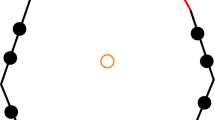Abstract
In this work, we introduce an \(hp\) finite element method for two-dimensional Poisson problems on curved domains using curved elements. We obtain a priori error estimates and define a local a posteriori error estimator of residual type. We show, under appropriate assumptions about the curved domain, the global reliability and the local efficiency of the estimator. More precisely, we prove that the estimator is equivalent to the energy norm of the error up to higher-order terms. The equivalence constant of the efficiency estimate depends on the polynomial degree. We also present an \(hp\) adaptive algorithm and several numerical tests which show the performance of the adaptive strategy.


















Similar content being viewed by others
References
Ainsworth M, Senior B (1997) Aspects of an adaptive \(hp\) finite element method: adaptive strategy, conforming approximation and efficient solvers. Comput Methods Appl Mech Eng 150:65–87
Ainsworth M, Senior B (1998) An adaptive refinement strategy for \(hp\)-finite element computations. Appl Numer Math 26:165–178
Armentano MG, Padra C, Rodriguez R, Scheble M (2011) An hp finite element adaptive scheme to solve the Laplace model for fluid-solid vibrations. Comput Methods Appl Mech Eng 200(1–4):178–188
Armentano MG, Padra C, Rodriguez R, Scheble M (2012) An hp finite element adaptive method to compute the vibration modes of a fluid-solid coupled system, CMES. Comput Model Eng Sci 84(4):359–382
Azaiez M, Deville MO, Gruber R, Mund EH (2008) A new \(hp\) method for the -grad(div) operator in non-Cartesian geometries. Appl Numer Math 58:985–998
Babuška I, Suri M (1994) The P and H-P versions of the finite element method. Basci Princ Prop SIAM Rev 36:578–632
Babuška I, Suri M (1987) The \(h\)-\(p\) version of the finite element method with quasiuniform meshes. RAIRO Modél Math Anal Numér 21:199–238
Boffi D, Costabel M, Dauge M, Demkowicz L (2006) Discrete compactness for the \(hp\) version of rectangular edge finite elements SIAM. J Numer Anal 44:979–1004
Ciarlet PG (1978) The finite element method for elliptic problems, North Holland, Amsterdam
Ciarlet PG, Raviart PA (1972) Interpolation theory over curved elements with applications to finite element methods. Comput Methods Appl Mech Eng 1:217–249
Demkowicz L (2007) Computing with \(hp\)-adaptive finite elements, Vol. 1. One and two dimensional elliptic and Maxwell problems. Chapman & Hall/CRC, Boca Raton
Demkowicz L, Kurtz J, Pardo D, Paszyński M, Rachowicz W, Zdunek A (2008) Computing with \(hp\)-finite elements. Vol. 2. Frontiers: three-dimensional elliptic and maxwell problems with applications. Chapman & Hall/CRC, Boca Raton
Dorfler W, Heuveline V (2007) Convergence of an adaptive hp finite element strategy in one space dimension. Appl Numer Math 57:1108–1124
García-Castillo LE, Pardo D, Gómez-Revuelto I, Demkowicz LF (2007) A two-dimensional self-adaptive \(hp\) finite element method for the characterization of waveguide discontinuities. Part I: Energy-norm based automatic \(hp\)-adaptivity. Comput Methods Appl Mech Eng 196:4823–4852
Girault V, Raviart PA (1986) Finite element methods for Navier–Stokes equations. Springer, Germany, Berlin
Grisvard P (1985) Elliptic problems in nonsmooth domain. Pitman, Boston
Guo BQ, Babuška I (1986) The h-p-version of the finite element method. Part 1. Comput Mech 1:21–41
Guo BQ, Babuška I (1986) The h-p-version of the finite element method. Part 1. Comput Mech 1:203–226
Melenk JM (2005) \(hp\)-interpolation of nonsmooth functions and an application to \(hp\)-a posteriori error estimation. SIAM J Numer Anal 43(1):127–155
Melenk JM, Wohlmuth BI (2001) On residual-based a posteriori error estimation in hp-FEM. Adv Comput Math 15:311–331
Oden JT, Wu W, Ainsworth M (1995) Three-step \(h\)-\(p\) adaptive strategy for the incompressible Navier–Stokes equations, modeling, mesh generation, and adaptive numerical methods for partial differential equations. IMA Math Appl 75:347–366
Oden JT, Demkowicz L, Rachowicz W, Westermann TA (1989) Toward a universal \(hp\) adaptive finite element strategy, part 2. A posteriori error estimation. Comput Methods Appl Mech Eng 77:113–180
Oden JT, Patra A, Feng YS (1992) An \(hp\) adaptive strategy. In: Noor AK (ed) adaptive, multilevel and hierarchical computational strategies, AMD vol. 157, pp 23–46. ASME Publications
Pardo D, García-Castillo LE, Demkowicz LF, Torres-Verdín C (2007) A two-dimensional self-adaptive \(hp\) finite element method for the characterization of waveguide discontinuities. Part II: Goal-oriented \(hp\)-adaptivity. Comput Methods Appl Mech Eng 196:4811–4822
Scott R (1975) Interpolated boundary conditions in the finite element method. SIAM J Numer Anal 12:404–427
Schwab Ch (1998) p- and hp- finite element methods, Theory and applications in solid and fluid mechanics (Numerical Mathematics and Scientific Computation). Oxford University Press
Tarancon JE, Fuenmayor FJ, Baeza L (2005) An a posteriori error estimator for the \(p\)- and \(hp\)-versions of the finite element method. Intern J Numer Methods Eng 62:1–18
Verfürth R (1996) A review of a posteriori error estimation and adaptive mesh-refinement techniques. Wiley & Teubner, New York
Zlâmal M (1973) Curved elements in the finite element method I. SIAM J Numer Anal 10(1):229–240
Acknowledgments
This work was partially supported by ANPCyT under grant PICT 2010-01675. The first author was partially supported by ANPCyT under grant PICT-2007-00910 and by Universidad de Buenos Aires under grant 20020100100143. The first and second authors are members of CONICET, Argentina. The authors thank Dr. Mariano Cantero for helpful discussions concerning this work.
Author information
Authors and Affiliations
Corresponding author
Additional information
Communicated by André Nachbin.
Rights and permissions
About this article
Cite this article
Armentano, M.G., Padra, C. & Scheble, M. An \(hp\) finite element adaptive scheme to solve the Poisson problem on curved domains. Comp. Appl. Math. 34, 705–727 (2015). https://doi.org/10.1007/s40314-014-0133-z
Received:
Revised:
Accepted:
Published:
Issue Date:
DOI: https://doi.org/10.1007/s40314-014-0133-z




